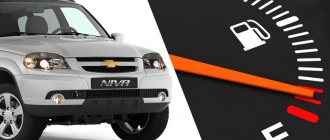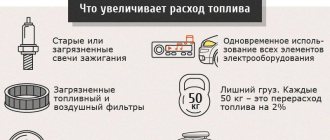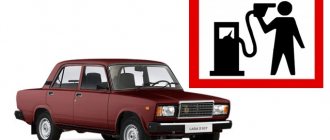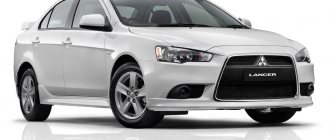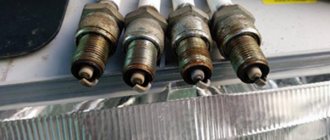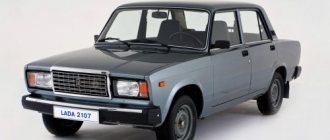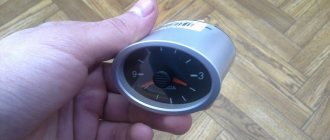Hello everyone. Recently connected the MMS to the machine's computer. I filled the tank full, reset the consumption readings on the standard on-board computer and on the MMS. Observations have shown that the principle of calculating fuel consumption is different. On the standard BC it shows at least two liters more than on the MMS. Which testimony should you believe? I'm still leaning towards the MMS readings.
Mileage: 20000 km
Recommendations
Comments 26
I don’t trust the BC consumption at all, only from refueling to refueling, I installed the jerrycan application on my phone and record the mileage and fuel filled there and it gives me the consumption. In winter, the consumption is high, taking into account warming up and sometimes driving through snowdrifts or with slipping; in summer, it is correspondingly less. The app now shows an average consumption of 10 liters per 100 km.
My instantaneous also varies, when you drive at a constant speed, then on the bk there is on average 0.4 liters more than on the mms, from this the average is also different, but at most by 0.4-0.5 liters
So wait, I’m now going to run for cola and popcorn and will continue to look at this holivar.
and yes, you have instant 1.2 in general. usually 0.8-0.9
After replacing the spark plugs, my level increased from 0.8-0.9 to 0.9-1.1 l/h.
It will show higher on the dashboard. Here the car is running and it divides what it spent on the spot into 100 km or something and gives the result. shows above in the sense that he doesn’t really want to throw them down and you think that the consumption is sometimes under 20. On a monotonous road, I dropped it on the dashboard and looked. the average consumption was 5.6-6.1 if you didn’t press hard. I only checked it in winter.
in motion, of course, the consumption will be more realistic.
Zdrastvui yevgeni ia toje xpchu takoi komp na svoi subarik postavit mojesh soveti dovat?
The calculation principle is the same. The engine ECU provides data via the CAN line about the duration of opening of the engine injectors. Knowing the duration of the injector opening and multiplying it by the calibration coefficient, you can determine the fuel consumption. The machine's BC uses a coefficient calculated for the installed engine. The MMC program uses a coefficient that may not correspond to the engine of your car.
do you want to say that we need to believe the testimony of BC? even if they show 15 liters?
You can calculate the consumption at gas stations and draw a conclusion about the correct fuel consumption. Fill the tank full. Reset average flow. Drive 100 km. Fill the tank full. How many liters did you fill and the average consumption will be. Compare with the values of BC and MMS and draw a conclusion that it shows correctly.
At gas stations they fill it up differently. some fill it up to the neck, and some until the first click of the gun. Also a subjective question.
Pour from a canister on the same level area through a measuring cup.
that's the point. Using the old old-fashioned method to measure? Then why all these bookmakers and systems that cannot be trusted.
I trust my bookmaker, it shows correctly. You have doubts and I wrote to you how to resolve them
The readings are absolutely identical, tested many times and over long distances, they may differ in the least significant digit and then ±0.2 liters. In the MMC in the single menu there is a correction factor, read why and how to correct it and do it.
Non-standard advice
The simplest advice would be to switch the car to consume natural gas. Of course, the fuel itself will not be consumed less, but the price of one kilometer of travel will be reduced by up to two times. Problems arise only in terms of too rapid wear of some parts.
So, for infrequent trips, there will be practically no benefit from such a procedure.
You can also give up comfort while driving. We're talking about turning off all electrical appliances, from the radio to the air conditioner. This will save from half to one liter of gasoline for every hundred kilometers driven.
There is an opinion that you can save money when coasting downhill. This is indeed true. But you also need to remember that control over the car becomes very low, and you significantly increase the danger of movement, both for yourself and for everyone around you. In addition, such movement can lead to brake failure.
If you move closely behind a large truck, your fuel consumption will actually be less. But this is only true for those situations when the truck is moving fast enough. Because if he is driving at a speed of 50 kilometers per hour, then moving in lower gears will only increase fuel consumption. In addition, you will significantly reduce your review.
Tire pressure can also be considered an important factor. As you know, if it is lowered, then fuel consumption will be higher, since the contact patch with the road increases, and rolling resistance will be greater. Therefore, if you increase the tire pressure, the contact patch will become smaller. This actually provides reduced fuel consumption.
The main thing is that you do not exceed the recommended parameters. The fact is that too high pressure leads to increased driving rigidity, as well as the risk of tire bursting on difficult sections of the road.
It is also important how high-quality fuel you refuel. When choosing the best gasoline, you can talk about reducing its consumption by several percent. In practice, this may be offset by a higher price for a specific brand of gasoline.
Among other things, you can advise making your driving style smoother, sharing costs with passengers, and also avoiding busy sections of the road using alternative routes.
We reset the daily mileage readings on the Lada Vesta
- We turn off the car engine.
- Squeeze the parking brake.
- We turn on neutral gear.
- Turn the key in the ignition switch to position “1”.
- We press two buttons at the end of the right switch.
- In the on-board speedometer menu, select the “daily mileage” category (on the right).
- Hold for 2 seconds, the indicators flash.
- Release both buttons and press them again.
- We exit the menu.
How are consumption rates determined?
Fuel consumption, that is, the amount of gasoline consumed per 100 km, is recognized in many countries as one of the most important characteristics of a car engine. Vehicle weight, engine efficiency, transmission ratios, power consumption of additional equipment, tire quality, fuel pump operation, braking and other factors affect specific fuel consumption. Aggressive, overly active driving also requires higher gas mileage.
Fuel consumption Mitsubishi Lancer 1.5, 1.6, 1.8, 2.0
In the recent past, fuel consumption calculations were determined by professional drivers during factory tests on specially equipped tracks. At the moment, the new principle of such testing shows high reproducibility of the results. But when a standardized test is carried out in a testing laboratory, the car is in good condition, filled with reference fuel, all additional electrical equipment, air conditioning and lighting are turned off. The stand automatically performs cycles of uniform motion and acceleration and deceleration.
Manufacturers publish data obtained on a test bench, which is not the norm for practical gasoline consumption. An aggressive driving style and second-to-second acceleration, engine problems and fuel metering systems, low tire pressure and vehicle load, jammed brakes and transmission malfunction are not all the reasons for incomplete combustion of fuel and, as a result, a significant increase in gasoline consumption. If the car is technically in good working order, then in normal driving conditions an experienced driver will be able to reduce fuel costs.
Lada Granta - fuel consumption in winter mode
How to reset the average fuel consumption on a Lada Vesta
To set the fuel consumption indicator to zero, you must:
- Turn off the engine.
- Engage neutral gear, squeeze the handbrake.
- Turn the ignition to position “1”.
- Press and hold the upper button of the lever - switch on the right side for 2 seconds.
- After the indicator flashes, briefly press the same button twice.
- After resetting the readings, press once to exit the “directory”.
Conclusion
Resetting the average fuel consumption of a Lada Vesta car to zero is quite simple; even an inexperienced car enthusiast can cope with the task. The presence of a “meter” allows you to track engine fuel consumption online.
If the range is exceeded, the driver can contact the service station for a comprehensive diagnosis, providing the recorded data to the specialists. This will make it easier to identify the breakdown. In all non-standard situations, seek help from service station specialists and auto shop managers.
Non-standard recommendations, their pros and cons
One of the simplest recommendations for car owners who want to save on fuel is advice on converting the car to natural gas. This will not lead to a significant reduction in the amount of fuel consumed, but will almost halve the cost of each kilometer of travel. This option also has one drawback - rapid wear of a number of parts. Let us note that such a transfer will be insignificant in a financial sense for drivers who rarely use their cars.
Lada Granta - fuel consumption in summer mode.
You can save on fuel at the expense of your own comfort when moving - refuse to use all electrical appliances (air conditioning, radio, etc.). This measure will allow you to save from 0.5 to 1 liter of fuel for every 100 km driven.
Many people believe that when coasting downhill, less gasoline is consumed, and this is absolutely true. But we should not forget about the weakening of control over the car during such movement, which poses a danger to the driver, passengers, and pedestrians. In addition, the result of such a ride can be faulty brakes.
It has been noticed that driving closely behind a heavy truck reduces gasoline consumption, but this rule only works when the truck in front is moving quickly. At a speed of 50 km/h, movement will occur in a lower gear and, on the contrary, gasoline consumption will only increase.
An important aspect is tire pressure. With reduced pressure, fuel consumption will increase due to an increase in the contact area between the wheel and the road surface, which will complicate the rolling process. Therefore, by increasing your tire pressure, you will reduce the amount of fuel your car consumes. The main thing is not to exceed the parameters recommended by the manufacturer, because very high pressure will increase the rigidity of movement, in addition, the danger of a tire rupture on difficult sections of the road will increase.
The quality of the fuel you use plays an important role in saving money. By choosing higher quality gasoline, you can slightly reduce fuel consumption, however, the high cost of such fuel can offset possible savings. In addition, drivers who want to save on gasoline are advised to switch to the smoothest possible driving style and try, if possible, to avoid congested road sections using alternative routes.
Reviews
| № | Positive |
| 1. | Vladimir Stepanovich , 44 years old (otzovik.com): I repeatedly searched for how to reset the meter readings, but never found it. Fortunately, my comrades suggested it. |
| 2. | Georgy Fedorovich , 40 years old (www.zr.ru): it’s very convenient with meters, you always see how much fuel the engine consumes. |
| 3. | Taras , 22 years old (autobann.su): before the Lada Vesta I had a Priora, there was no such odometer. Thanks to the domestic developer for new technologies. |
| 4. | Yaroslav , 33 years old (lada-vesta.net): the car is three years old, the instruments show clearly, without errors. |
| 5. | Stanislav Sergeevich , 43 years old (otzovik.com): I spend a lot of time behind the wheel, constantly on the road, without fuel consumption sensors. Helps track fuel volume. |
| 6. | Semenovich, 44 years old (www.zr.ru): I use devices every day, thanks to which I noticed that consumption is less when refueling at a certain gas station |
| 7. | Peter , 20 years old (autobann.su): in general, the panel is informative, but the font is not large enough. A person with poor vision needs to squint to see the indicators. |
| 8. | Slavik , 43 years old (lada-vesta.net): I slightly increased the brightness of the tidy, now all indicators are clearly visible, even in sunny weather. |
| 9. | Stepan Timofeevich , 39 years old (otzovik.com): the instrument panel works properly, no complaints. |
| 10. | Gennady Stepanovich , 43 years old (www.zr.ru): positive review of the car, good functionality, informative dashboard. |
| 11. | Semyon , 35 years old (autobann.su): in three years of using the car, I have never contacted a service station, except for scheduled maintenance. The car is assembled well, there are no comments. |
| Negative | |
| 12. | Dmitry Nikiforovich , 44 years old (www.zr.ru): the tidy began to fail after winter, apparently a failure occurred at the software level. I will contact the warranty officials. |
| 13. | Leonid Makarovich , 47 years old (otzovik.com): for a long time I could not reset the indicators, as it turned out, the problem was in the program code. |
| 14. | Stepanovich , 46 years old (autobann.su): I don’t like the dashboard, it’s not very informative, the font is small. Renault Logan of the second generation has a much better implementation. |
With engine VAZ-11183-50 1.6 82 l. With.
- Nadezhda, Irkutsk. The car impressed with its perky character, despite only 80 horsepower under the hood. The 1.6-liter unit is dynamic and economical, it has potential. Fuel consumption is 7-8 liters. The manual transmission is configured as it should, there is no need to look for gears. The cabin is quite spacious, but the seating position is purely vertical, you sit behind yourself.
- Oleg, Nikolaev. I'm happy with the car, this is my first car. Decent device, worth the money spent. With a 1.6 engine and manual transmission it consumes 8 liters per 100 km.
- Maxim, Kyiv. I purchased the car as a sedan. My Lada Granta is in good condition and I service it regularly. The service center works decently, all spare parts are available - they are inexpensive, and you won’t go broke on them. Fuel consumption 7 l/100 km.
- Larisa, Odessa. Lada Granta is a real anti-crisis car. Comfortable and dynamic, with soft suspension and quite modern equipment. Consumes an average of 8 liters of gasoline per 100 km. Under the hood there is a 1.6 82 liter engine. With..
- Alexey, Tomsk. The car is 2021, I have already driven it for 50 thousand km. I think that this car was not created to be replaced with another in three or four years. The car is quite durable, and spare parts are inexpensive, which means you can use it as much as you like. The quality of materials and components is poor, a C grade. For the money they ask for, Granta holds up well. The car is perfectly suited for Russian roads. The 82-horsepower engine is peppy and actively accelerates the light car. I have the most basic configuration, with a manual transmission and fuel consumption of 7-8 liters per hundred kilometers. The design is strict and quite modern.
- Konstantin, Sverdlovsk. I liked the car, it’s a car for all occasions. Suitable for the role of a first car. I’m just one of those people - I passed my license and bought a new Grant. I think that such cars are not worth buying on the supported market. It’s better to take a branded foreign car then. I have a Lada Granta in the back of a sedan. In general, this car is suitable for undemanding drivers who need a car with a basic set of functions. Gasoline consumption per hundred kilometers is 8-9 liters per 100 km.
- Oleg, Ekaterinoslavl. I've had the Lada Granta since 2021, I've been happy with it since the first day of the trip. It has a lot in common with the Lada Kalina, although it is a more budget car. Grant has a simpler interior, and in general everything looks simple and budget-friendly. Especially in my basic configuration. I bought the 82-horsepower version, which consumes an average of 8 liters of A-95.
- Igor, Kharkov. A great car for every day. If it breaks, I won't be too upset. Consumables and spare parts are cheap - patched up and on the road. A set of tools is always in the trunk, otherwise you never know. The peppy 1.6 engine eats 7-8 liters.
- Sergey, Yaroslavl. I liked the car. I think it’s better to buy our domestic products than Chinese ones. Of course, now there are Chinese cheaper than Granta. But the Russian car is somehow closer and more predictable. Granta's service is simply great, you won't get lost. Gasoline consumption is about 8 liters/100 km.
- Vladimir, Tver. I have a 2021 Lada Granta, with a mileage of 87 thousand at the moment. Good handling, comfortable suspension. All electronic systems such as ABS still work properly and accurately. There is no corrosion, the car consumes 8 liters.
Video - flow reset
I would like to summarize the information regarding the BC readings regarding fuel consumption. Using the “Info” button on the BC display, you can display four parameters: 1) Current consumption (CONSUM CUR L/100KM) - current fuel consumption; 2) “Average”* consumption (CONSUM AV L/100KM) - average fuel consumption after the last reset of this parameter; 3) Remaining km (REMNG) - the approximate number of km that can be driven with the remaining fuel in the tank; 4) “Average”* speed (AV KM/H) - average speed of the car after the last reset of this parameter;
*The word “average” in paragraphs 2 and 4 is put in quotation marks for a reason, because These parameters do not display classic average parameters, but data during engine operation, i.e. The time the car is parked with the engine running is also taken into account. That is, for example, if after the reset you started the engine and stood for 1 hour (warming up, etc.), and then drove for 1 hour at a speed of 100 km/h (in the end you drove 100 km), then the “average” speed according to BC will be = 100 km/(1h+1h)=50 km/h. The situation is similar with “average” consumption. Parameters from points 2 and 4 can be reset (zeroed) by selecting this parameter on the screen and holding down the “Info” button for a long time (until it is reset, a couple of seconds). Those. if it is necessary to measure these parameters while moving, then before starting the movement we reset both parameters and set off, after stopping we read the parameters.
Probably many remember the times when mileage reset was carried out by simply mechanically pressing a button on the dashboard. Every time in front of a gas station this action was carried out in order to calculate the average fuel consumption - this is what on-board computers looked like in those years. Now everything is much simpler - a lot of sensors measure a lot of parameters and provide all the necessary information in real time. But in order to understand this “simpler”, you need to very actively study the operating manual of the on-board computer, after which, perhaps, you will begin to succeed.
In this article, we will briefly describe the main functions of the on-board computer, and also provide an algorithm of actions that allows you to reset the gasoline consumption on the on-board computer of your Lada Vesta - this will save you from a long search for information in multi-page manuals.
Technical reasons for increased fuel consumption
Despite the fact that VAZ has stepped far forward in improving its products, many unresolved problems remain. And some of them have a direct impact on the amount of gasoline consumed.
Injector diagram (fuel supply to combustion chambers)
All influencing factors can be divided into “hardware” and “software”. This classification was the result of the use of an injection engine, as well as the abundance of sensors in the car’s design.
Incorrectly selected fuel
It is recommended to fill AvtoVAZ engines with 95-grade gasoline only. Only then will the engine control system begin to correctly calculate the parameters for preparing the fuel mixture. Therefore, when using gasoline with an octane number below 95, fuel consumption will increase and foreign vibrations may appear in its operation.
Electronic system errors
Main article: “Main malfunctions of the engine management system.”
They can be considered one of the simplest situations, since they can be corrected by simply contacting a specialized service center. Problems of this kind arise for the simple reason that some sensors that are used to prepare the working mixture begin to function incorrectly.
Typically, the “Check Engine” icon will light up on your car’s dashboard (main article: Why does the check engine light come on).
Diagnosis of car electronic systems
In particular, we are talking about
- temperature sensors,
- throttle position sensors,
- as well as mass air flow.
In the latter case, its breakdown may be due to the fact that the air filter has not been changed for a long time. And, of course, incorrect readings can result from false information from the oxygen sensor, which is also simply called a lambda probe.
All this can lead to both the preparation of a “lean” and “rich” mixture. As a result, power may be lost or fuel consumption may increase. A malfunction can be detected by diagnosing each sensor separately.
Fuel system pressure
In Fig. car fuel frame and receiver
This is another common breakdown. The fact is that the pressure level can be too high or low, although the second option is much more common. This can be determined when the engine loses power and you have to drive at higher speeds to maintain the desired dynamics. This all significantly increases fuel consumption.
If you have problems with the fuel rail, the car may not start.
Injector problem
If you do not monitor the condition of the power unit, this will lead to shortcomings in its operation. Most often, this concerns contamination of the injectors, which is followed by poor supply of the working mixture, so that the engine begins to “triple”, and you try to compensate for this by increasing the speed.
Catalyst destruction
Similar results occur when the catalyst burns out or even breaks down. Without going into detail about the specifics of this situation, we can simply conclude that if the catalyst is contaminated, a “rich” mixture will form. After this, additional heating of the catalyst occurs, reducing its service life and reducing engine power. Fuel consumption will be maximum.
Read more about fuel consumption standards for the Lada Granta Liftback here!
Motor temperature
In addition to all of the above, it would be a good idea to constantly monitor the engine temperature. If it is above 103 degrees, then the mixture will not be of sufficient quality. The engine will begin to operate on a “lean” mixture, reducing its power and increasing gasoline consumption.
Read more about the operating temperature of the Lada Granta engine here.
The main drawback is that the instrument panel on the Lada Granta does not have a real-time indication of the engine temperature, read how this can be fixed here.
If the engine has not yet warmed up, this leads to an increase in consumption due to the “enrichment” of the mixture. The level of overspending reaches 20 percent. In most cases, the cause must be found in the thermostat.
Main article: “Do you need to warm up the Lada Grant engine before driving?”
Incorrect engine operation
Increased fuel consumption may be due to a “broken” engine. That is, the engine is worn out. The main symptoms of engine wear will be:
- There is no compression.
- Maslozhor.
- Other.
- bad dynamics
- erratic engine operation
Engine life can be significantly reduced due to:
- incorrectly selected oil (choice of oil for an 8-valve valve, choice of oil for a 16-valve valve)
- insufficient running-in of components on a new car (read the material: “How to properly break-in an engine on a Grant)
- engine underheating to operating temperature
Air filter dirty
Old filter
And, of course, we must not forget that if air flows poorly through this filter, the effect of “oxygen starvation” will begin. This will entail a significant excess of gasoline consumption.
How to reduce consumption using “economical firmware”?
Considering that the Lada Granta has an on-board computer and a full set of electronic systems, you can flash this system yourself. That is, you replace the standard settings that were made at the factory with those that you consider necessary.
Of course, this can be considered a dangerous procedure, but it is worth remembering that the manufacturer may not have counted on the conditions under which a particular machine is operated. So, with such simple manipulations, fuel consumption can be reduced by up to 20 percent. If the result does not suit you, you can always return the original firmware.
The only advice would be not to perform these procedures if you have a valid car warranty. In addition, only professionals should do this. If you do this yourself, then you need to first study this topic in detail.
Description of the Lada Vesta on-board computer
Vesta's on-board computer has many useful functions, some of which are missing even from European and eastern competitors. We list some of the functions of this type of on-board computer:
- Total mileage over the entire life cycle of the vehicle (not reset)
- Short-term mileage for measuring individual distances (resettable)
- Current time (hh:mm)
- Time spent on current trip
- Average speed per trip
- Recommendation for gear selection
- Car electrical voltage
- Fuel consumption (per trip, average and current)
- Possible driving distance with current fuel supply
- Outside air temperature
And these are just the main frequently used functions, which were kindly provided by AvtoVAZ engineers. With so many options, managing your computer shouldn't be too easy. Next, let’s move on to the topic of the article and talk about resetting fuel consumption.
Lada Granta fuel consumption rate per 100 km 8-valve
Fuel consumption rate per 100 km
The Grant was initially equipped with an 8-valve engine, which was of two types. The main difference between them was that one of them has a power of 80 horsepower, and the other - 90. This engine accelerates the car to hundreds in just 12.0 seconds. The maximum speed of the car is up to 168.5 km/h. These figures are quite decent despite the fact that this car is a budget car. All Grants are petrol and their consumption per 100 kilometers is from 8.3 to 9.3 liters in the city, and outside the city - from 5.8 to 6.1 liters.
Reviews about gasoline consumption
- Erkhan, Moscow. I bought myself a 2011 grant. after I sold the good old Mazda '94. Overall the car is not bad, the design is very impressive. And the dimensions are generally not bad, somewhat similar to golf. In terms of power (80 hp) and consumption, I consider this version to be a good indicator of a good price/quality ratio. It consumes about 9 liters in the city, on the highway – around 6 liters.
- Andrey, Kyiv. Lada Granta 1.6 (80hp). Of all the domestically produced models, Grant's car is so far the best. Considering that the suspension is in good condition, you can turn a blind eye to the main shortcomings - poor sound insulation and oil gluttony. As for consumption, it stays somewhere around 9.5 liters in the city, and 6 liters outside of it.
- Ivan, Lipetsk. After I bought an 8-valve 2012, I realized that this car is a very ordinary nine. Joining many, I will say that in the middle everything is terribly noisy and holds together. It requires a lot of improvement regarding sound insulation, and the Granta's consumption is not impressive. The beast under the hood eats an average of about 8 liters in the city and 6 outside it with such a low power (80 hp).
- Mikhail, Voronezh. Lada Granta 1.6 (87 hp) 2014 MT. I was pleased with the purchase. The good news is that the engine is very economical and unpretentious. During the 6-month period of use, I only changed consumables and that’s it. If you stick to a speed of 110-115 km/h on the highway, then the fuel consumption is 6 liters, and in the city - 10 liters with traffic jams.
- Sergey, St. Petersburg. Lada Granta 1.6 (80hp). I, like many, was a supporter of old German cars, but it so happened that the opportunity arose to take the new 8-valve Grant 1.6. The first time after the acquisition I was pleasantly surprised, but later I was a little disappointed. A huge drawback of this car is a lot of noise and rattling. Fuel consumption is about 8.5 liters in the city and 6 liters on the highway, just like in the passport.
- Munir, Tambov. Not long ago I switched to a 2012 Grant with a manual transmission. Before that I drove a 5. The impressions, I will say, are very good, everything suits me, and the capacity of the trunk is very surprising. And the consumption is normal for my 8-cylinder “monster” with 82 hp. So far I can say that about 9.1 liters are burned in the city, and outside the city it’s generally 5.8 liters.
- Andrey, Chelyabinsk. I have an 8-valve Lada Granta with 80 hp. under the hood. I really like it, especially the handling on the road. I was also surprised by the size of the trunk - quite large. Regarding consumption, I can note that with such power it is quite adequate. I consistently eat 7.8 liters in a mixed cycle.
- Evgenia, Tver. My husband and I bought a 2011 Grant 1.6 in the hope that the car would last a long time, but after a while we were disappointed. Many things that seem to be of good quality eventually fail. In general, there are many shortcomings and shortcomings. This applies to both suspension and painting. Consumption averages 7.5 liters per 100 km. But most of all I regret that I bought a car with a manual – it’s hard for me to get used to it.
- Alexey, Nizhny Novgorod. Lada Granta 1.6 (87 hp) 2014 MT. After 3 months of driving and 10 thousand mileage, my conclusion is: this car is a great progress in domestic car production. Much of this Grant is new to VAZ. I liked it in everything, from handling and fuel consumption, to the size and capacity of the trunk. I spend 9 liters per hundred in the city, and about 5.9 liters on the highway.
- Artem, Moscow. I took a car with a power of 90 hp. with mechanics for the family and was pleasantly surprised. Its controls are reliable, easy and confident. The suspension doesn't disappoint either. Very good headlights and lighting. Consumption is a completely different matter: 8.5–9.0 liters in the city, 5.8 liters outside the city. In general, a car with such equipment for such money can be said to be ideal.
How to reset fuel consumption
Often car owners are faced with the fact that they cannot understand how to reset this or that parameter in a newly purchased car. This question did not pass by Lada either. So, in order to reset the gasoline consumption of a Lada Vesta car, you must perform the following steps:
- Turn on the ignition by turning the key to the appropriate position
- By short pressing two buttons (simultaneously) located at the end of the left switch, select the menu that shows the average fuel consumption
- While holding the top key (about 3 s), “fail” into the menu for changing settings (the fuel consumption value will flash)
- Hold down the top key again and reset the fuel consumption (until the value stops flashing).
Exit editing mode by pressing the bottom key.
Thanks for subscribing!
As you can see, resetting the average fuel consumption of the Lada Vesta is quite simple. Resetting data is performed in the same way for any other settings. If, instead of repeatedly pressing the button for a long time, you press it briefly, you will be able to change certain settings.
Factors influencing consumption
What is the fuel consumption of the Lada Granta? The point is that no one will say the exact number. After all, it depends on various factors. And in any answer, the car owner will use “somewhere”, “on average”. Therefore, it is worth understanding under what conditions high fuel consumption occurs. Let's consider the main factors:
- The condition of your engine. Yes, for a new car purchased in 2021, this is completely irrelevant, because it is ideal. But there is an unpleasant fact: 1% of power units when buying a new car will already have a bad technical part. And the point is not that the manufacturer installed an old engine, but that he specially flashed the ECU so that the consumption increased. In this case, you should reflash the device from an experienced specialist. In this case, you will lose the warranty of the official dealer, but the fuel consumption of the Lada-Grants will be as it should be.
- Loaded car. If you carry very large and heavy items, your car will consume significantly more fuel. This is fine. According to the laws of physics, the more a car weighs, the more energy it needs to move. You have to draw it from the fuel tank.
- Consumer devices: air conditioner, stove, music, and so on. All this consumes the car's gasoline.
- Speed. The optimum is between 90-120 kilometers per hour. When driving this way at low speeds, your fuel consumption will be low. This driving mode is considered suburban and is used only on highways/highways.
- Gasoline quality. Yes, even this affects fuel consumption. After all, if you fill in very good and expensive gasoline, it will not just burn out and, one might say, “evaporate.” And, of course, this will not have a detrimental effect on the technical part of your engine. This, by the way, is another point of high gasoline consumption. Please take this into account. Refuel only at proven gas stations.
- Your riding style. Aggressive driving can result in high fuel consumption. And the skills are low. After all, if you are an inexperienced driver, you will drive in second gear where others are in fourth.
An experienced car enthusiast drives at low speeds and high gear levels; in this mode, fuel consumption will indeed become very low.
As a rule, the Lada Granta is bought by those car enthusiasts who are interested in the opportunity to save money both on the purchase of the vehicle itself and on its operation. The mentioned model is precisely positioned by the manufacturer as a budget and compact model.
However, people are often interested in what the actual fuel consumption of the Lada Grant is per standard 100 km? This question often arises because many people record a significant excess of the indicator compared to the manufacturer’s promises.
In this article we will try to figure out how much fuel the Grant consumes for the mentioned 100 kilometers in reality.
On-board computer sound settings
Vesta’s on-board computer, as we already wrote at the beginning of the article, has many interesting functions that can surprise even owners of more expensive car brands. For example, the sound menu - it allows you to turn on/off the sounds of turn signals, warning sounds about the need to change gears and other sounds.
If you simultaneously press and hold both buttons on the end of the right switch, you will be taken to the menu for adjusting the volume of various sounds. When you add the volume of the turn signal, a squeak is added to the main sound of the relay, which, along with the setting, also changes the frequency (louder - lower frequency).
A long-awaited feature was also the ability to change the sound heard when the seat belt is not fastened. In addition, you can adjust the sounds of the parking sensor.
In fact, all the functions of BC Vesta have not yet been fully studied, and every time something new is discovered, which undoubtedly pleases car owners.
Hello everyone, how can I reset the average fuel consumption?
Similar articles
8 comments on “How to reset average fuel consumption”
Zakhar, this is the one who switches the wipers, right?
comrades, read the instructions for the car, you can learn a lot of interesting and informative things there))))
you take it, go into the forest, grab a stick and stuff it into the tank, then when you arrive at the gas station, you also believe
You switch to what you need to reset using the buttons on the paddle, press and hold reset
Sasha, You switch until you need to reset using the buttons on the paddle, press and hold the reset
When the blue 15A fuse burned out, my consumption went to zero
How are consumption rates determined?
Fuel consumption, that is, the amount of gasoline consumed per 100 km, is recognized in many countries as one of the most important characteristics of a car engine. Vehicle weight, engine efficiency, transmission ratios, power consumption of additional equipment, tire quality, fuel pump operation, braking and other factors affect specific fuel consumption. Aggressive, overly active driving also requires higher gas mileage.
In the recent past, fuel consumption calculations were determined by professional drivers during factory tests on specially equipped tracks. At the moment, the new principle of such testing shows high reproducibility of the results. But when a standardized test is carried out in a testing laboratory, the car is in good condition, filled with reference fuel, all additional electrical equipment, air conditioning and lighting are turned off. The stand automatically performs cycles of uniform motion and acceleration and deceleration.
Fuel consumption rates for all modifications of the VAZ 2110 and the main reasons for increased appetite
Manufacturers publish data obtained on a test bench, which is not the norm for practical gasoline consumption. An aggressive driving style and second-to-second acceleration, engine problems and fuel metering systems, low tire pressure and vehicle load, jammed brakes and transmission malfunction are not all the reasons for incomplete combustion of fuel and, as a result, a significant increase in gasoline consumption. If the car is technically in good working order, then in normal driving conditions an experienced driver will be able to reduce fuel costs.
Lada Granta - fuel consumption in winter mode
